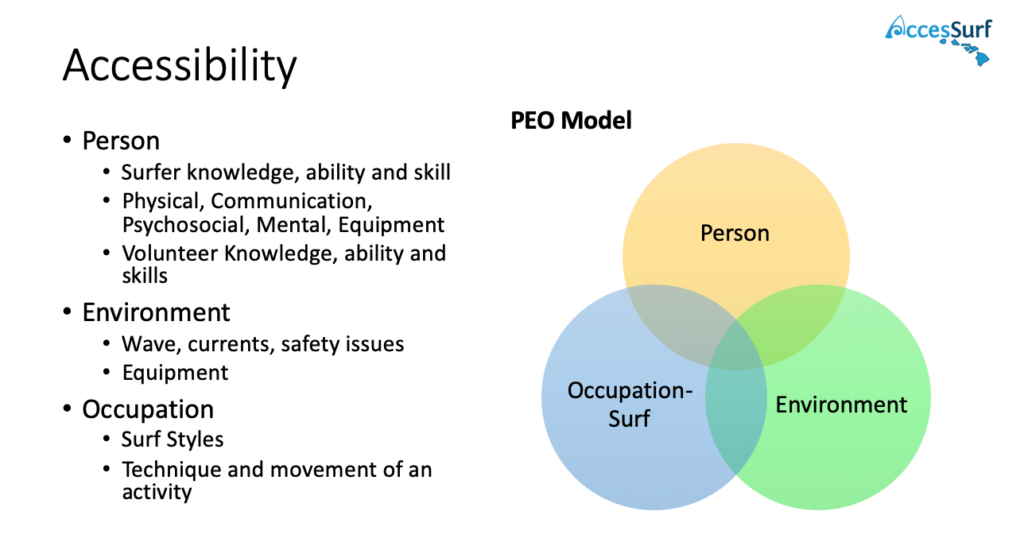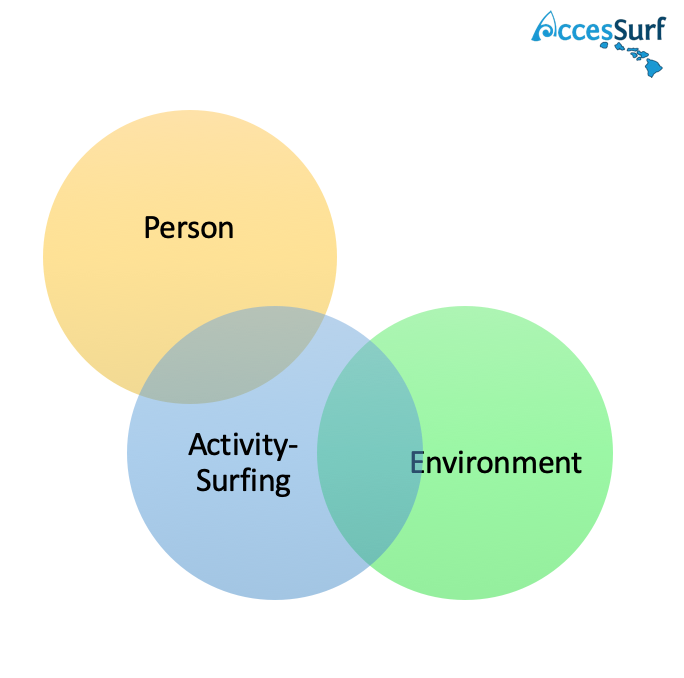Accessibility
Only 1 in 4 people with disabilities participates in sporting activities, leaving the majority of people with disabilities inactive.
We look at accessibility with an open perspective.
The person, environment, or activity can be altered to promote access to activities. When we look at a situation, the ways of supporting a person in an activity may vary. Some may like to access the water through the beach mat or by being carried or even crawling on the sand. ASH uses the social environment to create access to sports as well as the physical environment to build accessibility on the beach. We might even train the individual on techniques or postures to help them participate. Other personal factors could be fears, emotions, and beliefs about their ability to be active. We adapt the sports of surfing, paddling, and swimming by changing the form of the activity. For example, people surf prone and standing. People swim by floating and moving their body or by holding on the floats without volunteers holding onto them. People paddle by being on a boat and paddling with one arm on one side only. We can alter the activity to fit the needs of the AccesSurfer.
Balanced PEO for accessibility

Imbalanced PEO
Basic Disability Awareness
This page will provided you with some basic information on the common conditions and diagnoses among AccesSurf participants. This will help you understand one aspect of the person’s conditions.
AccesSurf provides programs for anyone with a cognitive or physical disability.
Before we go further on types of conditions, we need to emphasize that people with disabilities are — first and foremost — people. It is important to address how we talk to and about people with disabilities. At AccesSurf we use what’s known as person-first language.
- Person-First Language emphasizes the person, not the disability. By placing the person first, the disability is no longer the primary, defining characteristic of an individual. Acknowledge the person before you acknowledge their disability.
Say this:
“the individual missing a limb”
“person who uses a wheelchair”
“individual that is experiencing depression”
Not this:
“the amputee”
“wheelchair-bound” or “confined to a wheelchair”
“depressed person”
Typical Conditions
Our AccesSurfers may experience one or more conditions in life. Each individual has different life experiences, and that may not be reflected by others and the way they experience the same condition. The best thing to do is to use communication for the things you need to know that are related to participating in water activities and respect any personal boundaries that an AccesSurfer may have. Here is a list of the most common conditions that people experience in our programs. You will find more functional information in our function section.
- Spinal cord injury (SCI)
- Traumatic brain injuries (TBI)/ Acquired brain injury (ABI)
- Autism spectrum disorder (ASD)
- Amputation
- Vision impairment
- Muscular dystrophy (MD)
- Osteoarthritis (OA)
- Post-traumatic stress disorder (PTSD)
- Rheumatoid arthritis (RA)
- Cerebral palsy (CP)
- Multiple sclerosis (MS)
- Cardiovascular disease
- Hearing impairment
- Down syndrome
- Diabetes
- Epilepsy
- Erb’s palsy
Spinal Cord Injury (SCI)
- SCI occurs when there is any damage to the spinal cord that temporarily or permanently blocks communication between the brain and the body. SCI’s are referred to either as complete or incomplete. With a complete injury, no sensation or movement occurs below the injury site. An incomplete injury involves partial sensation and/or movement function below the injury site.
- To learn more information: https://www.unitedspinal.org or http://www.spinalinjury101.org/details
Traumatic Brain Injuries (TBI)/Acquired Brain Injury (ABI)
- Brain injuries occur when there is damage to the brain affecting a person physically, emotionally, or behaviorally. Brain injuries are called either traumatic or acquired, depending on the cause. Traumatic brain injuries (TBI) happen from a traumatic event such as a car accident or a fall. Acquired brain injury (ABI) happen from a nontraumatic injury such as a stroke or tumor.
- To learn more information: http://www.braininjury101.org/details or Brain Injury Association of America https://www.biausa.org/brain-injury
Autism Spectrum Disorder (ASD)
- ASD is a spectrum developmental disorder, which means symptoms can be mild, moderate, or severe. ASD can lead to differences in communication, sensory experiences, and social skills. People with ASD have difficulty communicating and understanding what other people think and feel. This makes it difficult for people with ASD to respond to gestures, facial expressions, touch, and even language. The individual’s experience and functionality range with ASD. Be open to communicate, ask others, and observe individuals.
- To learn more information: https://www.cdc.gov/ncbddd/autism/index.html
Amputation
- Amputation is the removal of a limb by injury, medical illness, or surgery. Loss of a limb produces a permanent limitation that can impact a person’s self-image, self-care, movement, balance, and can cause pain.
- To learn more information: https://medlineplus.gov/limbloss.html or https://www.ottobockus.com/prosthetics/info-for-new-amputees/information-for-lower-limb-amputees-and-their-families/
Vision Impairment
- Visual impairment is a loss in vision that cannot be corrected with glasses or contacts. Visual impairments reduce a person’s ability to perform tasks. Visual impairments can occur to anyone, at any age. Visual impairment can include cataracts, blindness, macular degeneration, etc.
Muscular Dystrophy (MD)
- MD is a group of genetic disorders that gradually weakens the body’s muscles. There are many different forms of MD. A person with MD gradually loses the ability to do things like walk, sit upright, breathe easily, and move the arms and hands. This increasing weakness can lead to other health problems.
- To learn more information: https://www.mayoclinic.org/diseases-conditions/muscular-dystrophy/symptoms-causes/syc-20375388
Osteoarthritis (OA)
- OA is the most common form of arthritis. OA occurs when the protective cartilage on the ends of bones wears down over time due to aging joints, injury, or obesity. Joints can become stiff causing pain, swelling, and lack of movement. The most commonly affected joints are those at the ends of the fingers, neck, lower back, knees, and hips.
- To learn more information: https://www.arthritis.org/about-arthritis/types/osteoarthritis/what-is-osteoarthritis.php
Post-Traumatic Stress Disorder (PTSD)
- PTSD is a disorder that can develop after seeing or living through a shocking, scary, or dangerous experience. PTSD does not just happen to combat veterans; PTSD can occur in all people. Symptoms may include flashbacks, nightmares, and severe anxiety, as well as uncontrollable thoughts about the event.
- To learn more information: https://www.mayoclinic.org/diseases-conditions/post-traumatic-stress-disorder/symptoms-causes/syc-20355967
Rheumatoid Arthritis (RA)
- RA is a chronic inflammatory disorder that affects the hands and feet first, but it can occur in any joint. RA can cause joint stiffness, pain, swelling and sometimes loss of joints.
- To learn more information: https://www.arthritis.org/about-arthritis/types/rheumatoid-arthritis/what-is-rheumatoid-arthritis.php
Multiple Sclerosis (MS)
- MS is a condition that affects the brain and spinal cord. Nerves have a protective covering that helps relay information throughout the body and to the brain. With MS, this protective covering is reduced, impacting the nerves’ ability to communicate with the body. There are 4 types of MS and symptoms may differ greatly from person to person. MS can affect movement, sensation, and speech.
- To learn more information: https://www.nationalmssociety.org/What-is-MS/Definition-of-MS
Cardiovascular Disease
- Cardiovascular disease describes a range of conditions that affect a person’s heart. Cardiovascular disease includes conditions that narrow or block blood vessels that can lead to a heart attack, chest pain, or stroke. Cardiovascular disease can occur genetically or from lifestyle choices. Heart disease places certain physical limitations on a person’s body.
- To learn more information: https://www.heart.org/en/health-topics/consumer-healthcare/what-is-cardiovascular-disease
Cerebral Palsy (CP)
- CP is a broad term that describes a group of non-progressive neurological (brain) disorders that cause the loss of normal motor function.
- CP is due to abnormal brain development, often before birth.
- Symptoms include exaggerated reflexes, floppy or rigid limbs, and involuntary motions. These appear by early childhood.
- To learn more information: https://www.yourcpf.org
Hearing Impairment
- Hearing impairment occurs when a person loses part or all of their ability to hear. Someone who has hearing loss might be able to hear some sounds or nothing at all. People also may use the words deaf, deafness, or hard-of-hearing when they’re talking about hearing loss. Hearing loss happens when there is a problem with one or more parts of the ear or ears, the nerves coming from the ears, or the part of the brain that controls hearing.
- To learn more information: https://www.asha.org/public/hearing/Hearing-Loss/ or https://www.who.int/news-room/fact-sheets/detail/deafness-and-hearing-loss
Down Syndrome (DS)
- Down Syndrome, also called Trisomy 21, is a condition in which a person is born with an extra chromosome. DS can cause delays in the way a person develops, mentally and physically. People with DS can have certain physical features, such as a flatter face and upward slanting eyes. They may have medical problems too, such as heart defects.
- To learn more information: https://www.ndss.org/about-down-syndrome/down-syndrome/
Diabetes
- Diabetes is a condition that occurs when the body is unable to regulate glucose (a type of sugar) normally. Blood glucose is the body’s main source of energy and comes from the food we eat. Over time, having too much or too little glucose in the blood can cause health problems. People living with diabetes must watch what they eat and drink and regularly check blood glucose levels. There are two types of diabetes: Type 1 and Type 2. People with diabetes can experience increased thirst and hunger, frequent urination, fatigue, blurred vision, and diabetic seizure.
- To learn more information: http://www.diabetes.org/diabetes-basics/
Epilepsy
- Epilepsy is a condition that affects that brain and causes repeated seizures. A seizure is a change in a person’s behavior that comes from abnormal electrical activity in the brain. Most of the time, seizures occur without warning, although some people have a funny feeling, an upset stomach, or a weird smell or taste right before a seizure. During a seizure, the person may fall down, shake, stiffen, throw up, drool, urinate (pee), or lose bowel control. Epilepsy can start at any age, and there are many different types
- Click on the link to learn more AccesSurf Seizure Safety Handout or https://www.mayoclinic.org/diseases-conditions/epilepsy/symptoms-causes/syc-20350093
Erb’s Palsy
- Erb’s palsy, also called brachial plexus birth palsy or Erb-Duchenne palsy, is a condition caused by nerve damage around the time of birth.
- Doctors or nurses pulling on a baby during a difficult delivery can damage the brachial plexus, or the network of nerves that sends signals from the spine to the shoulders, arms, and hands. The resulting condition, Erb’s palsy, prevents the baby from properly using their affected limb.
- Click on the link to learn more https://www.childbirthinjuries.com/erbs-palsy/


